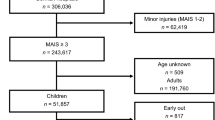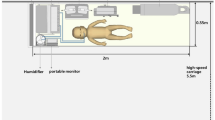Abstract
Background
Decision making regarding transportation mode after a traumatic injury may have a significant impact on outcomes, due to differences in time to definitive care. The objective of this study was to determine if transport mode had an impact on in-hospital mortality and discharge disposition in pediatric trauma patients.
Methods
Data were abstracted from the National Trauma Data Bank from 2007 to 2016 comparing helicopter and ground transportation modes effects on mortality and discharge outcomes. The primary outcome was in-hospital death, while the secondary outcome was discharge home without services (DCHWOS). Analyses included logistic regression modeling and propensity score matching.
Results
Significant variables from univariate analysis were included in the multivariate, propensity-matched regression model. Pediatric trauma patients transported by helicopter had lower odds of mortality (OR 0.69 [0.64,0.75]) and higher odds of DCHWOS (1.29 [1.20,1.39]). There were no differences in overall mechanism, but individual injury patterns showed higher odds of mortality.
Conclusion
Critical decisions regarding triage of patients by different modes of transport occur every day. This study supports the current literature on the topic and shows a potential additional benefit of a meaningful discharge outcome for those transported by helicopter.
Impact
-
This study may impact prehospital triage decision making process for pediatric trauma patients on mortality.
-
Prehospital transport mode may contribute to pediatric trauma discharge outcomes.
-
Highlights the need for future research regarding non-clinical data that is unable to be abstracted from national databases (e.g., family dynamics, insurance status, weather, access to post-discharge resources).
This is a preview of subscription content, access via your institution
Access options
Subscribe to this journal
Receive 14 print issues and online access
$259.00 per year
only $18.50 per issue
Buy this article
- Purchase on Springer Link
- Instant access to full article PDF
Prices may be subject to local taxes which are calculated during checkout


Similar content being viewed by others
Data availability
Data was obtained from the National Trauma Data Bank which is publicly available data reported to the American College of Surgeons and access to all the data used in this manuscript can be available upon request through their website.
References
Cunningham, R. M., Walton, M. A. & Carter, P. M. The major causes of death in children and adolescents in the United States. N Engl J Med 379, 2468–2475 (2018).
Pham H., Puckett Y., Dissanaike S. Faster on-scene times associated with decreased mortality in Helicopter Emergency Medical Services (HEMS) transported trauma patients. Trauma Surgery & Acute Care Open, vol. 2, no. 1, 2017
Michaels D., Pham H., Puckett Y., Dissanaike S. Helicopter versus ground ambulance: review of national database for outcomes in survival in transferred trauma patients in the USA. Trauma Surgery & Acute Care Open, vol. 4, no. 1, 2019, https://doi.org/10.1136/tsaco-2018-000211.
Odetola, F. O., Mann, N. C., Hansen, K. W. & Bratton, S. L. Factors associated with time to arrival at a regional pediatric trauma center. Prehosp. Disaster Med. 31, 4–9 (2016).
Träff H., Hagander L., Salö M. Association of Transport Time with Adverse Outcome in Paediatric Trauma. BJS Open, vol. 5, no. 3, 2021, https://doi.org/10.1093/bjsopen/zrab036.
Ringburg, A. N. et al. Helicopter emergency medical services (HEMS): impact on on-scene times. J. Trauma Acute Care Surg. 63, 258–262 (2007).
Brown, J. B. et al. Helicopters and injured kids: Improved survival with scene air medical transport in the pediatric trauma population. J. Trauma Acute Care Surg. 80, 702–710 (2016).
Galvagno, S. M. Jr et al. Association between helicopter vs ground emergency medical services and survival for adults with major trauma. JAMA 307, 1602–1610 (2012).
Haas, B. et al. The mortality benefit of direct trauma center transport in a regional trauma system: a population-based analysis. J. Trauma Acute Care Surg. 72, 1510–1517 (2012).
Committee on Hospital Care and Institute for Patient and Family Centered Care. Patient- and family-centered care and the pediatrician’s role. Pediatrics 129, 394–404 (2012).
Delgado, M. K. et al. Cost-effectiveness of helicopter versus ground emergency medical services for trauma scene transport in the United States. Ann. Emerg. Med. 62, 351–364.e19 (2013).
Abernethy, M. Patient outcomes from ground vs helicopter emergency medical services: the challenges of an accurate comparison. JAMA Netw. Open 4, e2033362 (2021).
Acknowledgements
We would like to thank the University of Texas Health Science Center, Department of Surgery, Division of Trauma and Critical Care and Division of Pediatrics for their support in this project
Disclosure
The authors of this manuscript have no relevant financial relations ships and have nothing to disclose with regards to this manuscript.
Funding
No sources of funding were utilized in the completion of this study.
Patient consentData was abstracted from the publicly available national trauma databank and did not require consent for this manuscript.
Author information
Authors and Affiliations
Contributions
A.V., D.L., S.N., and A.M. contributed to the writing, data collection, literature search, and data analysis of the manuscript. A.M., K.R. contributed to the critical revision of this manuscript and data collection of this study.
Corresponding author
Additional information
Publisher’s note Springer Nature remains neutral with regard to jurisdictional claims in published maps and institutional affiliations.
Supplementary Information
Rights and permissions
Springer Nature or its licensor (e.g. a society or other partner) holds exclusive rights to this article under a publishing agreement with the author(s) or other rightsholder(s); author self-archiving of the accepted manuscript version of this article is solely governed by the terms of such publishing agreement and applicable law.
About this article
Cite this article
Ciaraglia, A., Lumbard, D., Murala, A. et al. Comparison of helicopter and ground transportation in pediatric trauma patients. Pediatr Res 95, 188–192 (2024). https://doi.org/10.1038/s41390-023-02761-5
Received:
Revised:
Accepted:
Published:
Issue Date:
DOI: https://doi.org/10.1038/s41390-023-02761-5



